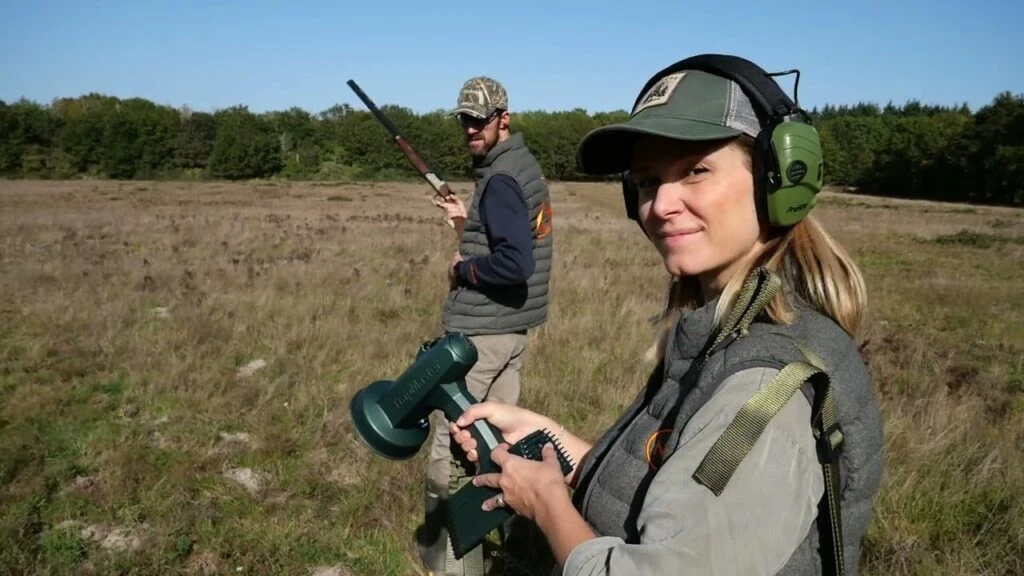Clay pigeon shooting with Nordic Clays | A beginner’s guide
Picture this: on a crisp morning, shooters from all walks of life gather, their eyes set on the sky. They’re part of a rapidly growing community, joining the ranks of over 10 million enthusiasts who revel in the thrill of clay pigeon shooting. This sport, transcending age and background, has seen a remarkable surge in popularity, becoming a favored pastime for many seeking both challenge and camaraderie.
In this beginner’s guide, we’ll dive into the world of clay pigeon shooting, with a special focus on an innovative and responsible choice: eco-friendly Nordic clays. These clays, crafted with sustainability at their core, offer a unique blend of environmental consciousness and superior performance. As we explore the basics of the sport, the significance of using Nordic clays will be highlighted, showcasing their benefits not just to the shooter, but to the environment as well. Join us in discovering how clay pigeon shooting with Nordic clays is not just a sport, but a step towards a more sustainable future.
Read about eco-friendly clay pigeon shooting

The basics of clay pigeon shooting
Clay pigeon shooting, a sport that perfectly blends skill, precision, and the great outdoors, has a rich history and an ever-growing following. Here, we delve into the fundamentals of this fascinating sport, from its origins to the essential equipment, and introduce the innovative concept of eco-friendly Nordic clays.
Overview of the sport
Clay pigeon shooting originated as a means to simulate bird hunting, allowing hunters to practice their skills off-season. It dates back to the early 20th century when glass balls or live pigeons were initially used as targets. As the sport evolved, clay targets replaced live pigeons, giving rise to the name “clay pigeon shooting.” Today, it’s recognized not only as a recreational activity but also as a competitive sport, with numerous events and championships held worldwide. The essence of the sport lies in shooting clay targets flung into the air at high speeds, requiring sharp reflexes and accurate aim.
Equipment and gear
The right equipment is crucial for any clay pigeon shooter, whether a beginner or a seasoned pro.
- Shotguns: The most commonly used guns are over-and-under, side-by-side, semi-automatic, and pump-action shotguns. The choice depends on the shooter’s preference and the specific requirements of the shooting discipline.
- Ammunition: Shotgun cartridges vary in shot size and weight, tailored to different shooting ranges and conditions. It’s important to select the right cartridge for the type of shooting you’ll be doing.
- Safety gear: Safety cannot be overstated in clay pigeon shooting. Essential gear includes ear protection, eye protection, and a shooting vest or jacket. These items protect against noise, flying debris, and recoil.
- Additional accessories: Other accessories like gun slips, cartridge bags, and cleaning kits also play a vital role in the shooter’s arsenal.
Take a look at the TrapMaster from Nordic Clays.
The role of eco-friendly clays
A significant development in the world of clay pigeon shooting is the introduction of eco-friendly clays, particularly Nordic clays. Unlike traditional clays, which are often made with materials that can be harmful to the environment, Nordic clays are crafted using biodegradable, non-toxic components. This means they break down naturally without leaving any harmful residue in the environment.
Nordic clays are designed to be as robust and efficient as their traditional counterparts, ensuring that shooters do not have to compromise on quality or performance. By choosing Nordic clays, shooters can enjoy their sport while actively contributing to environmental conservation. This sustainable approach aligns with the growing global emphasis on eco-friendly practices in all aspects of life, including sports.

Getting started with clay pigeon shooting
Embarking on your journey in clay pigeon shooting is an exciting adventure. This section is dedicated to helping beginners get off to a flying start, from finding the right shooting range to learning the basics of the sport, all while keeping safety at the forefront.
Read about biodegradable clay pigeons
Finding a shooting range
Research online: Start by searching online for shooting ranges near you. Many ranges now highlight their eco-friendly practices, including the use of Nordic clay pigeons. Websites and social media platforms are great resources for this information.
Check for certifications: Look for ranges that are certified or affiliated with national shooting sports organizations. These ranges are more likely to adhere to high standards of safety and quality, and they might offer Nordic clay options.
Visit the range: If possible, visit the range in person. This allows you to get a feel for the environment, ask questions about their use of Nordic clays, and see the facilities firsthand.
Ask for recommendations: Don’t hesitate to ask fellow enthusiasts or join online forums and social media groups related to clay pigeon shooting. Experienced shooters can provide valuable insights and recommendations.
Learning the basics
Understand the equipment: Familiarize yourself with the different types of shotguns and understand the basics of handling and loading the gun safely.
Stance and grip: Learn the correct stance for balance and stability, and how to hold the shotgun correctly to manage recoil and improve accuracy.
Eye dominance: Determine your dominant eye, as it plays a crucial role in aiming accurately.
Shooting techniques: Start with the basic shooting techniques, such as the ‘swing through’ and ‘maintained lead’ methods. These techniques involve tracking the clay and understanding when to shoot.
Take lessons: Consider taking lessons from a qualified instructor. They can provide personalized guidance and help you develop good habits from the start.
Safety first
Proper handling of equipment: Always handle firearms with care. Keep the gun unloaded until ready to shoot and always point the muzzle in a safe direction.
Wear protective gear: Always wear ear and eye protection. This is non-negotiable, regardless of your experience level.
Be aware of your surroundings: Always be conscious of where others are in relation to your shooting. Maintain a safe distance from other shooters and be aware of the range’s safety guidelines.
Follow range rules: Adhere strictly to the rules and guidelines of the shooting range. These are in place for your safety and the safety of others.
Learn to recognize misfires and malfunctions: Understand how to safely handle a misfire or a malfunction in your shotgun. If in doubt, always seek assistance from a range officer or experienced shooter.
By following these guidelines, beginners can embark on their clay pigeon shooting journey with confidence and safety. Remember, the aim is to enjoy the sport while respecting the environment and prioritizing safety.
Beginner guide in clay pigeon shooting
Stance: Your stance is the foundation of a good shot. Stand with your feet shoulder-width apart, with your lead foot slightly forward. This position should feel balanced and comfortable, allowing you to rotate your upper body smoothly.
Grip and mount: Hold the shotgun firmly but not too tightly. When mounting the gun to your shoulder, ensure it fits snugly into the pocket of your shoulder to help absorb recoil. The cheek should rest comfortably against the stock to achieve a consistent line of sight.
Aiming and focusing: Unlike rifle shooting, clay pigeon shooting relies more on instinct than sight. Focus on the clay rather than the gun barrel. Trust your hand-eye coordination to guide the shot.
Follow through: After taking a shot, continue the motion of the gun. Stopping abruptly can throw off your aim. Follow-through is key to hitting moving targets.
Common challenges and how to overcome them
Hitting moving targets: Beginners often struggle with leading the target. Practice with different speeds and angles, and remember to shoot where the clay is going, not where it has been.
Recoil management: The kickback from shooting can be surprising. Proper stance and gun fit can mitigate this. If recoil is a significant issue, consider using a gun with less power while you build confidence.
Concentration and fatigue: Mental and physical fatigue can impact performance. Take breaks, stay hydrated, and don’t be too hard on yourself. Endurance will build over time.

Practice makes perfect
Regular practice: Consistency is key in clay pigeon shooting. Try to shoot regularly to develop muscle memory and refine your technique.
Vary your practice: Don’t just practice the shots you’re good at. Challenge yourself with different types of throws and angles.
Learn from mistakes: Analyze your misses. Was it an issue with timing, aim, or something else? Understanding what went wrong is crucial for improvement.
Seek feedback: Don’t hesitate to ask for feedback from more experienced shooters or coaches. They can offer insights and tips that are invaluable for a beginner.
Enjoy the process: Remember, every expert shooter was once a beginner. Enjoy the learning process and celebrate your progress, no matter how small.
By focusing on these tips, beginners can rapidly improve their skills in clay pigeon shooting. Remember, the journey is as rewarding as the destination. So, load up, take aim, and enjoy the thrill of breaking your first clay!
Read about why clay pigeon shooting is the perfect outdoor activity
Embrace the challenge and joy of clay pigeon shooting
To all beginners embarking on this exciting sport: embrace each moment, from the thrill of hitting your first clay to the satisfaction of mastering a challenging shot. Regular practice, a focus on safety, and a willingness to learn will guide you on this journey. And as you progress, remember to enjoy the process, celebrate your achievements, and continue to advocate for sustainable practices in sports.
Clay pigeon shooting with Nordic clays is not just a sport; it’s an experience that blends excitement, skill, and a commitment to the environment. So, take aim and enjoy every shot – the sky’s the limit!










